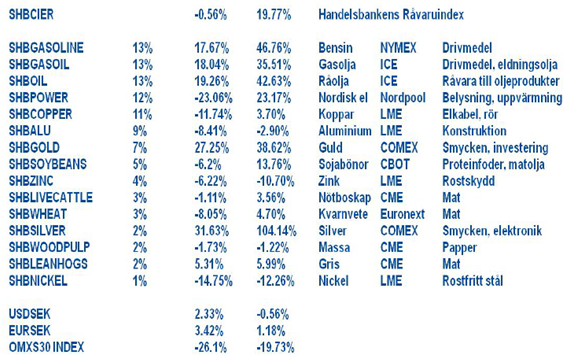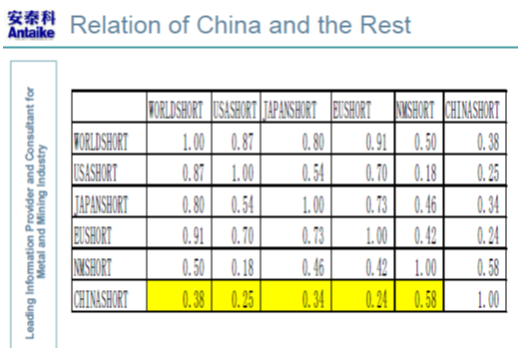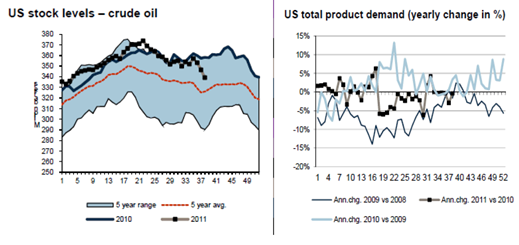Analys
SHB Råvarubrevet 23 september 2011
 Det har återigen varit en turbulent vecka med kraftiga fall på såväl aktie- som råvarumarknaderna efter förnyad oro kring den ekonomiska tillväxten. Vårt Råvaruindex är nu ned (-0.5 procent) för första gången i år. Federal Reserves beskrivning av läget som ”signifikanta nedåtrisker mot de ekonomiska utsikterna” tillsammans med svaghetstecken i preliminära inköpsindex från både Kina och Euroområdet har pressat framför allt de konjunkturkänsliga råvarorna som olja och basmetaller. Procentuellt sett har nedgången på olja, ca 7 procent, inte varit lika stor som på basmetallerna där bla nickel och koppar fallit med hela 15 procent. Det är helt riskaptiten som styr prisutvecklingen. Osäkerheten har bitit sig fast och vi räknar med fortsatt kraftiga kursrörelser där förhoppningarna i allt större utsträckning ställs till bolagen och verkliga förbrukningssiffror. Marknaden handlas mot slutet av veckan kvar på låga nivåer utan någon egentligen rekyl. Att marknaderna faller trots G20 uttalanden tyder på att det underliggande är mycket svagt och det känns som om en eventuell rekyl kan komma att dröja, speciellt eftersom även dollarn stärkts och verkar negativt för prisbilden. På måndag kommer dessutom viktig europeisk statistik när det tyska Ifo-institutet presenterar sina siffror över stämningsläget i ekonomin vilket med största sannolikhet kommer att påverka råvarumarknaderna endera hållet. Intressant att se om IMF mötet i helgen kan ge något stöd.
Det har återigen varit en turbulent vecka med kraftiga fall på såväl aktie- som råvarumarknaderna efter förnyad oro kring den ekonomiska tillväxten. Vårt Råvaruindex är nu ned (-0.5 procent) för första gången i år. Federal Reserves beskrivning av läget som ”signifikanta nedåtrisker mot de ekonomiska utsikterna” tillsammans med svaghetstecken i preliminära inköpsindex från både Kina och Euroområdet har pressat framför allt de konjunkturkänsliga råvarorna som olja och basmetaller. Procentuellt sett har nedgången på olja, ca 7 procent, inte varit lika stor som på basmetallerna där bla nickel och koppar fallit med hela 15 procent. Det är helt riskaptiten som styr prisutvecklingen. Osäkerheten har bitit sig fast och vi räknar med fortsatt kraftiga kursrörelser där förhoppningarna i allt större utsträckning ställs till bolagen och verkliga förbrukningssiffror. Marknaden handlas mot slutet av veckan kvar på låga nivåer utan någon egentligen rekyl. Att marknaderna faller trots G20 uttalanden tyder på att det underliggande är mycket svagt och det känns som om en eventuell rekyl kan komma att dröja, speciellt eftersom även dollarn stärkts och verkar negativt för prisbilden. På måndag kommer dessutom viktig europeisk statistik när det tyska Ifo-institutet presenterar sina siffror över stämningsläget i ekonomin vilket med största sannolikhet kommer att påverka råvarumarknaderna endera hållet. Intressant att se om IMF mötet i helgen kan ge något stöd.
Vid China Metal Forum som hölls i veckan gav kinesiska analyshuset Antaike sin syn på metallmarknaden och de ser för närvarande ingen direkt försvagning i Kinesiska förbrukningssiffror. Inte heller några tecken på överkapacitet inom stålindustrin där man för närvarande har ett rekordhögt kapacitetsutnyttjande om närmare 715 miljoner ton årlig produktion. De visade också en ganska intressant bild över korrelationen mellan Kina och övriga världen där Kina i ganska liten grad påverkas av den globala utvecklingen, se nedan.
Handelsbankens Råvaruindex

Handelsbankens råvaruindex består av de underliggande indexen för respektive råvara. Vikterna är bestämda till hälften från värdet av global produktion och till hälften från likviditeten i terminskontrakten.
Olja
Brentoljan har fallit med närmare 7 procent under veckan till lite drygt 105 dollar per fat. Det är den lägsta nivån sedan början av augusti. Lagernivåerna kom in långt under förväntan, råoljelagren föll hela 7.3 miljoner fat mot 0.3 miljoner fat väntat, och har därmed fallit 18 miljoner fat de senaste tre veckorna, se nedan. Denna veckans siffra kan delvis förklaras av ett högre kapacitetsutnyttjande, 86.3procent mot 84.7 procent förra veckan. Samtidigt var importen något lägre, 8.35 miljoner fat/dag mot tidigare 8.54 miljoner fat/dag.
Guld
Guldet har fallit närmare 7 procent under veckan vilken är den största rörelsen sedan 20008. Guldet handlas under 1700 dollar mot slutet av veckan vilket är den lägsta nivån på över 6 veckor. VI varnade förra veckan för fallande pris på guld eftersom marknaden blivit ordentligt utsträckt på uppsidan under augusti och september. Det som dessutom hänt denna vecka är att guldet dragits med ned i det allmänna råvaruraset eftersom man också sålt guld för att täcka förluster på andra tillgångar. Vi anser fortfarande att guld har en given plats i den långsiktiga sparportföljen, men just nu är det svårt att motivera Guld som tillflyktsort eftersom vi är inne i en djup korrigering. Vi tror därför att hösten kommer att bjuda på bättre tillfällen att komma in i marknaden.
El
Inga större rörelser på elmarknaden under veckan där första kvartalet stärktes med strax över en procent. Samtidigt som fallet på fossila bränslen tynger sentimentet verkade väderomslaget mot en något torrare period för uppsidan. Det är fortsatt rejält blött under inledningen av nästa vecka men sen ser det ut som vi får en högtrycksetablering. Det finns dock risk för att högtrycket viker söderut och lågtrycken får fäste igen vilket bör fortsätta att pressa marknaden. Vidare har vi också fortsatt låga spotpriser i Norden så sentimentet känns svagt om något.
Vete
Terminspriser på vete har backat under den gångna veckan, påverkat framförallt av en bred nedgång på de finansiella marknaderna. Fortsatt låg efterfrågan på amerikanskt vete har även det fortsatt att pressa ned priserna. Egypten köpte i veckan 240.000 ton vete från Ryssland, vilket ytterligare bekräftade Rysslands dominans på exportmarknaden. Ryska priserna är fortfarande klart lägre än både franska och amerikanska, konkurrensen väntas dessutom öka från Ukraina, Kazakstan och till viss del även Indien och Pakistan. Vädret utvecklas väl i Australien och en liten mängd har lindrat torkan i Argentina – men mer regn behövs. Kazakstan har varit blött för skörd men torrare väder väntas. Det är fortfarande för torrt för sådd av höstvete i stora delar av USA, med endast väldigt begränsad nederbörd. Torrt väder hämmar höstsådden även i Ukraina, väderprognoser lovar ingen större förändring under de närmaste två veckorna. Fokus under veckan har dock inte varit på fundamentala faktorer.
Majs
Majsen har tappat kraftigt i pris under veckan, till stor del på grund av allmänt fallande råvarupriser. Inga större nyheter har kommit som kan ge stöd åt priserna. Rykten om att Kina visat intresse för köp av uppemot 5 miljoner ton majs av amerikanskt eller argentinskt ursprung har ännu ej bekräftats. Faktum kvarstår dock att lagernivåer är låga, både i USA och globalt sett, vilket bör begränsa en fortsatt nedgång. Samtidigt är efterfrågan låg och osäkerheten fortsatt stor angående nivån på den amerikanska skörden – en del rapporter pekar på skördar över förväntan och andra tvärtom, vilket gör situationen svårbedömd.
[box]SHB Råvarubrevet är producerat av Handelsbanken och publiceras i samarbete och med tillstånd på Råvarumarknaden.se[/box]
Ansvarsbegränsning
Detta material är producerat av Svenska Handelsbanken AB (publ) i fortsättningen kallad Handelsbanken. De som arbetar med innehållet är inte analytiker och materialet är inte oberoende investeringsanalys. Innehållet är uteslutande avsett för kunder i Sverige. Syftet är att ge en allmän information till Handelsbankens kunder och utgör inte ett personligt investeringsråd eller en personlig rekommendation. Informationen ska inte ensamt utgöra underlag för investeringsbeslut. Kunder bör inhämta råd från sina rådgivare och basera sina investeringsbeslut utifrån egen erfarenhet.
Informationen i materialet kan ändras och också avvika från de åsikter som uttrycks i oberoende investeringsanalyser från Handelsbanken. Informationen grundar sig på allmänt tillgänglig information och är hämtad från källor som bedöms som tillförlitliga, men riktigheten kan inte garanteras och informationen kan vara ofullständig eller nedkortad. Ingen del av förslaget får reproduceras eller distribueras till någon annan person utan att Handelsbanken dessförinnan lämnat sitt skriftliga medgivande. Handelsbanken ansvarar inte för att materialet används på ett sätt som strider mot förbudet mot vidarebefordran eller offentliggörs i strid med bankens regler.
Finansiellt instruments historiska avkastning är inte en garanti för framtida avkastning. Värdet på finansiella instrument kan både öka och minska och det är inte säkert att du får tillbaka hela det investerade kapitalet.
Analys
Tightening fundamentals – bullish inventories from DOE

The latest weekly report from the US DOE showed a substantial drawdown across key petroleum categories, adding more upside potential to the fundamental picture.

Commercial crude inventories (excl. SPR) fell by 5.8 million barrels, bringing total inventories down to 415.1 million barrels. Now sitting 11% below the five-year seasonal norm and placed in the lowest 2015-2022 range (see picture below).
Product inventories also tightened further last week. Gasoline inventories declined by 2.1 million barrels, with reductions seen in both finished gasoline and blending components. Current gasoline levels are about 3% below the five-year average for this time of year.
Among products, the most notable move came in diesel, where inventories dropped by almost 4.1 million barrels, deepening the deficit to around 20% below seasonal norms – continuing to underscore the persistent supply tightness in diesel markets.
The only area of inventory growth was in propane/propylene, which posted a significant 5.1-million-barrel build and now stands 9% above the five-year average.
Total commercial petroleum inventories (crude plus refined products) declined by 4.2 million barrels on the week, reinforcing the overall tightening of US crude and products.


Analys
Bombs to ”ceasefire” in hours – Brent below $70

A classic case of “buy the rumor, sell the news” played out in oil markets, as Brent crude has dropped sharply – down nearly USD 10 per barrel since yesterday evening – following Iran’s retaliatory strike on a U.S. air base in Qatar. The immediate reaction was: “That was it?” The strike followed a carefully calibrated, non-escalatory playbook, avoiding direct threats to energy infrastructure or disruption of shipping through the Strait of Hormuz – thus calming worst-case fears.

After Monday morning’s sharp spike to USD 81.4 per barrel, triggered by the U.S. bombing of Iranian nuclear facilities, oil prices drifted sideways in anticipation of a potential Iranian response. That response came with advance warning and caused limited physical damage. Early this morning, both the U.S. President and Iranian state media announced a ceasefire, effectively placing a lid on the immediate conflict risk – at least for now.
As a result, Brent crude has now fallen by a total of USD 12 from Monday’s peak, currently trading around USD 69 per barrel.
Looking beyond geopolitics, the market will now shift its focus to the upcoming OPEC+ meeting in early July. Saudi Arabia’s decision to increase output earlier this year – despite falling prices – has drawn renewed attention considering recent developments. Some suggest this was a response to U.S. pressure to offset potential Iranian supply losses.
However, consensus is that the move was driven more by internal OPEC+ dynamics. After years of curbing production to support prices, Riyadh had grown frustrated with quota-busting by several members (notably Kazakhstan). With Saudi Arabia cutting up to 2 million barrels per day – roughly 2% of global supply – returns were diminishing, and the risk of losing market share was rising. The production increase is widely seen as an effort to reassert leadership and restore discipline within the group.
That said, the FT recently stated that, the Saudis remain wary of past missteps. In 2018, Riyadh ramped up output at Trump’s request ahead of Iran sanctions, only to see prices collapse when the U.S. granted broad waivers – triggering oversupply. Officials have reportedly made it clear they don’t intend to repeat that mistake.
The recent visit by President Trump to Saudi Arabia, which included agreements on AI, defense, and nuclear cooperation, suggests a broader strategic alignment. This has fueled speculation about a quiet “pump-for-politics” deal behind recent production moves.
Looking ahead, oil prices have now retraced the entire rally sparked by the June 13 Israel–Iran escalation. This retreat provides more political and policy space for both the U.S. and Saudi Arabia. Specifically, it makes it easier for Riyadh to scale back its three recent production hikes of 411,000 barrels each, potentially returning to more moderate increases of 137,000 barrels for August and September.
In short: with no major loss of Iranian supply to the market, OPEC+ – led by Saudi Arabia – no longer needs to compensate for a disruption that hasn’t materialized, especially not to please the U.S. at the cost of its own market strategy. As the Saudis themselves have signaled, they are unlikely to repeat previous mistakes.
Conclusion: With Brent now in the high USD 60s, buying oil looks fundamentally justified. The geopolitical premium has deflated, but tensions between Israel and Iran remain unresolved – and the risk of missteps and renewed escalation still lingers. In fact, even this morning, reports have emerged of renewed missile fire despite the declared “truce.” The path forward may be calmer – but it is far from stable.
Analys
A muted price reaction. Market looks relaxed, but it is still on edge waiting for what Iran will do

Brent crossed the 80-line this morning but quickly fell back assigning limited probability for Iran choosing to close the Strait of Hormuz. Brent traded in a range of USD 70.56 – 79.04/b last week as the market fluctuated between ”Iran wants a deal” and ”US is about to attack Iran”. At the end of the week though, Donald Trump managed to convince markets (and probably also Iran) that he would make a decision within two weeks. I.e. no imminent attack. Previously when when he has talked about ”making a decision within two weeks” he has often ended up doing nothing in the end. The oil market relaxed as a result and the week ended at USD 77.01/b which is just USD 6/b above the year to date average of USD 71/b.

Brent jumped to USD 81.4/b this morning, the highest since mid-January, but then quickly fell back to a current price of USD 78.2/b which is only up 1.5% versus the close on Friday. As such the market is pricing a fairly low probability that Iran will actually close the Strait of Hormuz. Probably because it will hurt Iranian oil exports as well as the global oil market.
It was however all smoke and mirrors. Deception. The US attacked Iran on Saturday. The attack involved 125 warplanes, submarines and surface warships and 14 bunker buster bombs were dropped on Iranian nuclear sites including Fordow, Natanz and Isfahan. In response the Iranian Parliament voted in support of closing the Strait of Hormuz where some 17 mb of crude and products is transported to the global market every day plus significant volumes of LNG. This is however merely an advise to the Supreme leader Ayatollah Ali Khamenei and the Supreme National Security Council which sits with the final and actual decision.
No supply of oil is lost yet. It is about the risk of Iran closing the Strait of Hormuz or not. So far not a single drop of oil supply has been lost to the global market. The price at the moment is all about the assessed risk of loss of supply. Will Iran choose to choke of the Strait of Hormuz or not? That is the big question. It would be painful for US consumers, for Donald Trump’s voter base, for the global economy but also for Iran and its population which relies on oil exports and income from selling oil out of that Strait as well. As such it is not a no-brainer choice for Iran to close the Strait for oil exports. And looking at the il price this morning it is clear that the oil market doesn’t assign a very high probability of it happening. It is however probably well within the capability of Iran to close the Strait off with rockets, mines, air-drones and possibly sea-drones. Just look at how Ukraine has been able to control and damage the Russian Black Sea fleet.
What to do about the highly enriched uranium which has gone missing? While the US and Israel can celebrate their destruction of Iranian nuclear facilities they are also scratching their heads over what to do with the lost Iranian nuclear material. Iran had 408 kg of highly enriched uranium (IAEA). Almost weapons grade. Enough for some 10 nuclear warheads. It seems to have been transported out of Fordow before the attack this weekend.
The market is still on edge. USD 80-something/b seems sensible while we wait. The oil market reaction to this weekend’s events is very muted so far. The market is still on edge awaiting what Iran will do. Because Iran will do something. But what and when? An oil price of 80-something seems like a sensible level until something do happen.
-

 Nyheter4 veckor sedan
Nyheter4 veckor sedanStor uppsida i Lappland Guldprospekterings aktie enligt analys
-

 Nyheter4 veckor sedan
Nyheter4 veckor sedanSilverpriset släpar efter guldets utveckling, har mer uppsida
-

 Nyheter3 veckor sedan
Nyheter3 veckor sedanUppgången i oljepriset planade ut under helgen
-

 Nyheter2 veckor sedan
Nyheter2 veckor sedanMahvie Minerals växlar spår – satsar fullt ut på guld
-

 Nyheter3 veckor sedan
Nyheter3 veckor sedanLåga elpriser i sommar – men mellersta Sverige får en ökning
-

 Analys3 veckor sedan
Analys3 veckor sedanVery relaxed at USD 75/b. Risk barometer will likely fluctuate to higher levels with Brent into the 80ies or higher coming 2-3 weeks
-

 Nyheter2 veckor sedan
Nyheter2 veckor sedanOljan, guldet och marknadens oroande tystnad
-

 Nyheter2 veckor sedan
Nyheter2 veckor sedanJonas Lindvall är tillbaka med ett nytt oljebolag, Perthro, som ska börsnoteras















